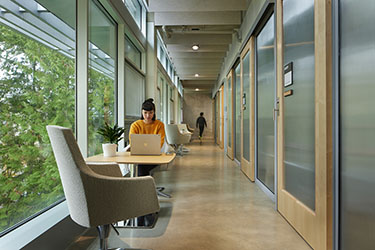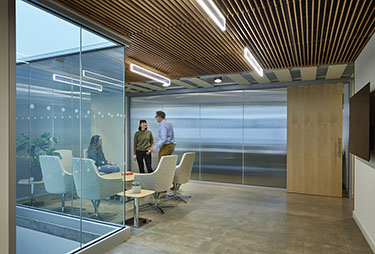|
Subscribe / Renew |
|
|
Contact Us |
|
| ► Subscribe to our Free Weekly Newsletter | |
| home | Welcome, sign in or click here to subscribe. | login |
Construction
| |
 |
May 11, 2023
Wellness nestles in the trees at The Evergreen State College
NAC

van der Veen
|
National statistics confirm that this generation of college students is facing physical and emotional issues like never before, and yet stigmas still exist that hinder those who are struggling from seeking care.
According to the National College Health Assessment during the 2020-2021 academic year, nearly 75% of college students in the U.S. reported moderate or severe psychological distress. Even before the pandemic, schools around the country were facing a surge in demand for care that far outpaced capacity, and it was becoming evident that the traditional counseling center model was ill-equipped to address the issue.
Connected to mental health concerns is the general decline of student physical health, also exacerbated by COVID-19. A yearly national survey by the Higher Educational Research Institute at UCLA shows that today only 50% of incoming freshmen report an above average ranking in physical health. Obesity among students continues to be a growing concern. Per the Obesity Medicine Association, college students today are among the most health-affected population in the U.S., with one-third having significant weight issues.
WHAT IS SO DIFFERENT TODAY?
College students currently are confronting a unique array of challenges, from increased coursework, family and relationship responsibilities, adjustment to campus life, work, and economic strain, to social equity issues, fear of violence, substance abuse, political acrimony, and aftereffects of the pandemic. This sociological cocktail not only strains the health and wellbeing of college students, but also the institutional staff, which negatively impacts graduation rates everywhere.
THE EVERGREEN STATE COLLEGE
These issues are manifesting throughout the public and private college system in Washington state, including The Evergreen State College near Olympia. In the context of outdated and unwelcoming facilities dispersed throughout the Evergreen campus, the college was having difficulty encouraging students to seek health and wellness support. Moreover, an internal campus health survey confirmed a widening gap in percentage of usage between Caucasian students and students of color, especially Native Americans.
With urgency, NAC was commissioned by Evergreen to create a transformative new health center that celebrates student wellness while dissipating the negative stereotype associated with receiving care.
The project was initially envisioned by the college as a traditional subdivided medical clinic. Discussions with the staff clarified the opportunity to accomplish much more. Not only was there a growing desire to destigmatize medical and mental health support, but the stakeholder team also wanted to approach health from an integrated perspective, connecting mental and physical wellness with fitness, dining, living on campus, and academic achievement.
While working closely with the Student Wellness Services staff in visioning and programming, the NAC team introduced the college to WELL Building and biophilia principles. A concept quickly emerged surrounding the Danish concept of “hygge,” a word referring to a mood of coziness and contentment.
Hygge also informs the art of building a sanctuary and community, a feeling of belonging to the moment and to each other, and of celebrating everyday pleasures. From a hygge perspective, the stakeholder team was able to focus on simple and natural approaches and solutions that would have the greatest positive impact on students and staff.
One significant challenge was the location selected for the new wellness center — the top floor of an existing concrete classroom building, which was not ideal for exploring new WELL Building and biophilic ideas. But whereas the old clinic’s programs were on the outskirts of the campus, the new wellness center would be in the heart of student activities and quite visible.
A series of questions provoked the design direction: How to create a safe and welcoming place for all students? How can the institution seamlessly offer interconnected medical and mental health services? How can the institution integrate fitness, dining, and wellness with student academic success? And how can the new clinic encourage students to stop by for wellness information and teaching seminars?
The central design concept brings all the clinic’s functions into the core of the space, allowing open circulation and gathering areas along the perimeter with broad views directly into the surrounding tree canopy. All the internal spaces have glazing that provides a variety of privacy levels while ushering in natural daylight and the healing power of nature.
Placing contiguous medical and counseling services under one roof, the new facility now provides integrated care to engage students in healing, growing, and developing lifelong wellness habits. The program is subdivided into clearly defined zones to promote easy wayfinding, while the public lobby, reception, and waiting area greet visitors immediately off the vestibule in a deliberate effort to destigmatize self-care.
For those who have been on the iconic Evergreen campus, the idea of the college nestled in the woods is quite evident. The new student wellness center rises students off the forest floor and into the canopy of the trees to experience wellness integrated with nature.
Ron van der Veen is a principal at NAC.
Other Stories:
- Why Seattle has become a hotbed for life sciences
- New chapter for life sciences starts in the U District
- Tepid appetite for local lab space continues
- What does it take to convert offices to biotech lab space?
- Best practices for successful outcomes to complex health care projects
- ‘Supersized’ team finds success at Seattle Children’s Forest B
- Transforming the care model in the Rogue Valley
- The evolution of science: trends affecting the science workplace
- Considerations for successful adaptive reuse projects




